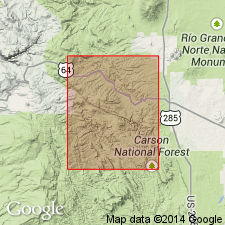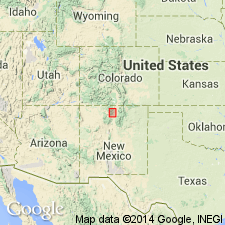
- Usage in publication:
-
- Esquibel member
- Modifications:
-
- Original reference
- Dominant lithology:
-
- Conglomerate
- Sandstone
- Siltstone
- AAPG geologic province:
-
- San Juan basin
Summary:
Pg. 45-46. Esquibel member of Los Pinos formation. Arkosic sandstone, sandy conglomerate, some thin beds of tuff or tuffaceous siltstone, and felsitic tuff. Thickness 600 feet. Underlies Cordito member (new); overlies Biscara member (new). Name credited to Butler (unpub. dissert.). Biscara and Esquibel members as differentiated by Butler, mapped here as single unit, Biscara-Esquibel member (new). Age is Miocene(?) or Pliocene(?).
Exposed westward from near divide on Tusas-Tres Piedras Road, [Tusas quadrangle (adv. sheet, 1918), Rio Arriba Co., central northern NM].
[Type area: Esquibel Canyon, , about 4 mi north-northwest of Tres Piedras, in secs. 3, 4, 5 and 6, T. 28 N., R. 9 E., Tres Piedras and Mule Canyon 7.5-min quadrangles, Rio Arriba Co., Carson National Forest area, central northern NM.]
[Additional locality information from USGS historical topographic map collection TopoView, accessed June 8, 2014.]
Source: US geologic names lexicon (USGS Bull. 1200, p. 1288); supplemental information from GNU records (USGS DDS-6; Denver GNULEX), GNC index card files (USGS-Menlo).

- Usage in publication:
-
- Esquibel Member*
- Modifications:
-
- Overview
- AAPG geologic province:
-
- San Luis basin
- San Juan basin
Summary:
Upper Oligocene to Miocene Esquibel Member (Butler, 1946, Ph.D. thesis, Harvard University) is the basal member of Los Pinos Formation, Taos Co, NM, San Luis basin. Present in Tusas Mountains, Rio Arriba Co, NM, San Juan basin. Overlies El Rito Formation, Conejos Formation, Treasure Mountain Tuff, Masonic Park Tuff, or Precambrian rocks depending on locality. Is interlayered with Hinsdale Formation. Underlies Cordito Member (adopted) of Los Pinos locally. Cordito is 2 m.y. younger at base than Esquibel. Is composed of poorly to well-sorted sandy conglomerate with gravelly sandstone, and locally occurring mudflow deposits. Volcaniclastic conglomerates with clasts as large as 2 m, generally subrounded are most common. Clasts include felsic and intermediate volcanic rocks, pumice fragments, minor basalt and variety of Precambrian rocks (schist, granite, quartzite). Some conglomerates are reworked Treasure Mountain Tuff. Conglomerates commonly fill channel cuts. Sandstones are fine to coarse grained, moderately well sorted and laminated or cross bedded, and composed of feldspar and quartz, volcanic rock, pumice and volcanic glass fragments. Is up to 270 m thick in Tusas Mountains; it thins south.
Source: GNU records (USGS DDS-6; Denver GNULEX).
For more information, please contact Nancy Stamm, Geologic Names Committee Secretary.
Asterisk (*) indicates published by U.S. Geological Survey authors.
"No current usage" (†) implies that a name has been abandoned or has fallen into disuse. Former usage and, if known, replacement name given in parentheses ( ).
Slash (/) indicates name conflicts with nomenclatural guidelines (CSN, 1933; ACSN, 1961, 1970; NACSN, 1983, 2005, 2021). May be explained within brackets ([ ]).

